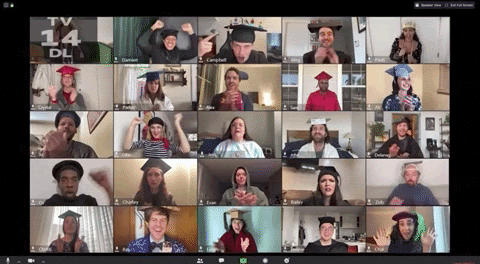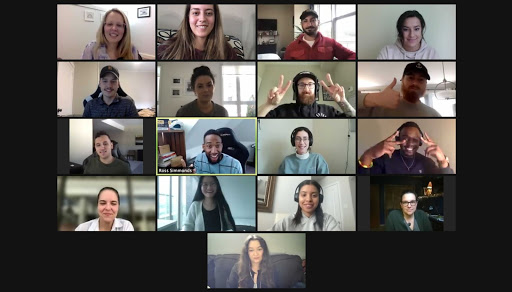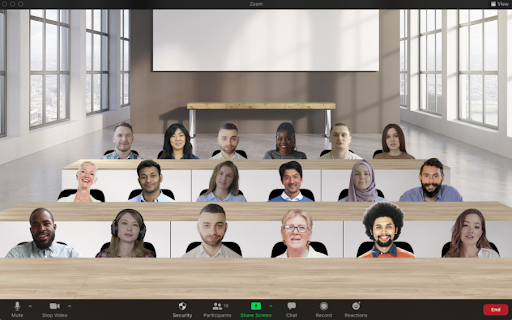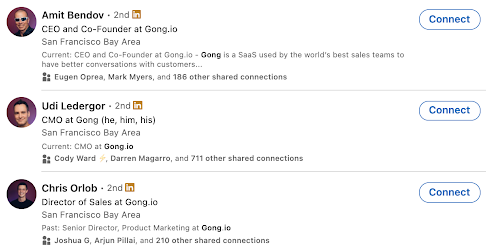Article's Content
Welcome to Volume 29!
While the vaccine rollout is underway, we aren’t out of the virtual woods yet.
Virtual webinars and distanced conferences aren’t going away anytime soon, and Zoom wants to make sure they can create an experience that will thrive through this time and long after we are back to normalcy.
Before we get into that, here’s a peek at what’s to come:
- Conferences on Zoom are getting a facelift
- Gong’s killer LinkedIn strategy
- Google shuts down the bidding strategy rumor

Quality content is critical for driving sales, increasing audience engagement, and influencing the entire sales funnel! But, coming up with and creating content can be tiresome.
To save you the time, we’ve compiled a short (but ultra sweet) list of the crème de la crème of B2B marketing resources to make things a little easier: 7 Go-To Content Marketing Resources (For B2B Marketers).
Give it a read-through, and thank our Digital Account Manager, Saad Zora, for the insights!
Zoom’s Looking A Lot Better
💻 Zoom fatigue got you feeling like turning your camera off and tuning out?
😴 Tired of being bombarded with your boss’s face in full screen at 1080p?
😷 Sick of seeing everyone stuck in their own box during gallery view?
👯 Just been craving a more realistic view of your audience?
Well then, Zoom has the solution for you.
Webinars, conferences, and calls happening via Zoom are about to change for the better.
Instead of relying on gallery view to see your team and getting distracted by the glimpse of everyone’s background…👇

… Zoom is creating an immersive scene functionality… 👇

… which is going to change the face (pun intended) of virtual webinars and conferences.
Instead of being stuck in 4×4 boxes or interacting with one face at a time in speaker view, Zoom is creating a way to have your audience placed in seats, replicating a conference-like setup.
These immersive scenes are entirely customizable by the meeting’s host. You can set a custom background theme and create layouts for where participant videos will be embedded within a shared scene. As you can see in the image above, the call is set up to imitate a classroom or meeting room.
What’s great about this is that this update will benefit connectivity and community during virtual events.
How? By making you feel like you’re a part of the group again, not isolated in your remote workspace. Seeing everyone seated next to each other will create that sense of community we’ve all been missing. And removing individual backgrounds lends to this connectivity as no one looks siloed or in obviously different spaces.
An additional feature rolling out is audience reactions. Hosts won’t be left grabbing at subtle shoulder-up body language to gain a sense of engagement and enjoyment. Now audience members can spam the thumbs-up reaction to show the host they support the topic; in opposition, a slew of thumbs-down reactions can indicate a misalignment of interest.
Other webinar-based updates include customized lobbies, breakout rooms, and secure debrief rooms for organizers and panelists to regroup after presentations.
Side Note: There is no release date for all these features, and Zoom has put out a disclaimer stating “products or functionality mentioned in this post are subject to change at Zoom’s sole discretion and may not be delivered as planned or at all.”
Key Takeaways
- Immersive scenes will benefit connectivity and community.
- Zoom is focusing on improving its webinar and virtual conference experience.
- Stress-induced by the close proximity of Zoom call attendants’ faces will be reduced.
Gong’s LinkedIn Strategy Is Anything But A Gong Show
Content-based culture starts at the top, with the team buying in from the top-down.
Gong is a leading SaaS company with a CEO that understands and respects content marketing. With 15+ years of experience in software marketing and previously working with Gong’s CMO Udi Ledergor, Amit Bendov (Gong’s CEO) has injected marketing into Gong’s DNA. With this sort of leadership, it’s clear why it’s no surprise that Gong is crushing it on LinkedIn.
Quick background: LinkedIn is the go-to distribution platform for B2B goods and services due to the 61 million LinkedIn users that are senior-level influencers and the 40 million in decision-making positions.
The Gong team, or Gongsters as they call themselves, are very proud to work at the company and often rep the company’s signature purple. Glancing at their LinkedIn profile pictures, they present a unified front as they pose in front of Gong’s purple gradient backdrop.

But that’s enough on their aesthetics as there is more to Gong’s LinkedIn strategy than providing a cohesive front.
Gongsters have a passion for understanding what type of content satisfies their audience best on LinkedIn, which we call content-market fit.
Content-market fit: when a piece of content’s value, the customer’s needs/wants, and the distribution channels leveraged by your brand all align.
Gong knows that their audience is looking for opinions, techniques, and data surrounding sales, and they’ve identified that their audience is spending time on LinkedIn. Thus satisfying the content-market fit formula.
You may be wondering, why are we focusing so much on Gong’s LinkedIn strategy?
First off – because content distribution is king.
Secondly, and more importantly, because Gong uses “follow us on LinkedIn” as the CTA accompanying blog posts.

And this isn’t something we see too often.
Compared to its product rival Chorus with 20,491 LinkedIn followers, Gong has 73,154 followers 🤯! Gong is close to quadrupling the number of followers that Chorus has 🤯.
Sure, it’s one thing to have attracted followers, but it’s another to ensure you provide value, which Gong does well.
Sharing about 10-15 posts a week to their company page, Gong doesn’t waste their opportunity to generate social traffic. For context, B2B and SaaS companies share, on average, 10-15 posts a year.
It is that level of volume and consistency that pushes Gong to win! Social platforms love consistency; the more content you publish, the greater your chances are of being noticed.
I’m only scratching the surface on how impressive and vital LinkedIn is to Gong’s marketing strategy. For the full breakdown, check out how Gong’s LinkedIn Strategy: Is Breaking Through The Social Media Noise.
Key Takeaways
- Standing out on LinkedIn is achievable through brand cohesion.
- Content-market fit is crucial to developing a quality content marketing strategy.
- Gong has mastered breaking through LinkedIn’s noise by prioritizing consistency in their distribution.
Google Comes Clean
A rogue post on Google’s developer blog regarding a bid strategy update sparked controversy when it was misinterpreted.
The misinterpretation had readers believing that two smart bidding strategies were going away. When in fact, that wasn’t the case at all.
Not every pay-per-click (PPC) aficionado bought into these rumors; some understood the real messaging behind the blog post.
Smart bidding strategies aren’t going anywhere; however, Google Ads’ User Interface (UI) is getting a makeover.
That was the big release — a makeover. Who would have thought it would lead to stark controversy and nervous PPCers.
This update came after a round of user feedback when Google discovered that it wasn’t always clear to advertisers which bidding strategy was best for them.
Not to discredit the rumor mill entirely, Google Ads are moving target CPA and target ROAS into the Maximize Conversions bucket and the Maximize Conversion Value bucket, respectively. I can see how this could be misleading as they are no longer standing on their own as a bid strategy.

Anyway, Google came out and confirmed that the machine learning behind target CPA and target ROAS’s bid strategies would remain the same. All functionality will be the same as before, but the advertiser’s setup will be slightly different.
In a twist of irony, this makeover is intended to simplify the decision-making process for advertisers when setting up their bidding strategy.
Key Takeaways
- Smart bidding strategies aren’t going anywhere.
- Google Ads interface has undergone a UI-based makeover.
- This update will make it easier for advertisers to understand which bidding strategy is right for them.
OTHER NEWS OF THE WEEK:
🚙 In the first quarter of 2021, Tesla grew 74%, beating out expectations before its shares began to ease after hours.
🚙 In another car news, Lyft sold its self-driving unit to Toyota’s Woven Planet for $550M!
💳 FinTech company Brex raised $425M at a $7.4B valuation in the face of the ongoing corporation spending war.
BRAIN FOOD OF THE WEEK:
I recently discovered two things about Domino’s; they have a pizza calculator and a “mascot” called The Noid.
This mascot was an 80’s brand icon whose mission was to prevent Dominos from delivering pizza on time, and it’s coming back in connection to something relevant to my generation – autonomous delivery! As a tech native zillennial, autonomous delivery is something I can get behind and am excited about.
It may seem interesting to connect an 80s icon to the futuristic technology of autonomous delivery, but it is, in fact, a huge branding win. In this 30 second advertisement, Dominos can highlight the skillful maneuvering of their autonomous vehicles without calling any attention to it. The Noid is back to its old antics of messing with the delivery vehicle, but with no driver in sight, Dominos is still able to best it and get the delivery made on time.
This retro connection to a newfound idea helps create buy-in from the not-so tech native generations who may be hesitant to support autonomous vehicles. While also reviving the games The Noid was famous for, in partnership with Crash Bandicoot: On The Run.
TWITTER THREAD OF THE WEEK:
Brand Positioning by The Voice of Marketing
WHAT WE’RE WIRED INTO THIS WEEK 🎧:
The Dark Side of the Moon by Pink Floyd (Best Track: Brain Damage)
Originally sent out, by me Cali B, on Thursday, April 29, 2021.
Stay up to date with all of our latest findings by subscribing to our newsletter today. Signing up also gives you early access to Ross’ Tuesday essay full of exclusive industry insights.
Quick, do it now before the next drop!







